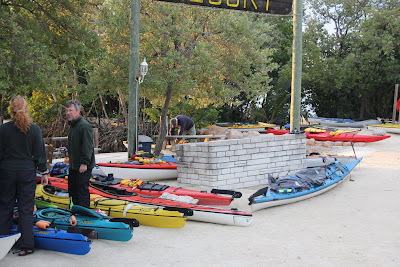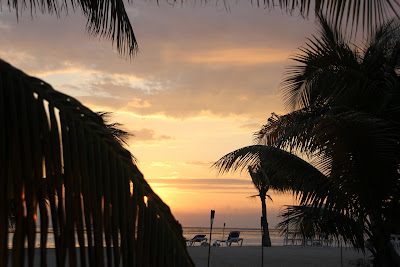Horrible as pictures go, but our first day did start with a grey
sky on a grey sea, but note how the starting paddlers are already
disappearing over the horizon.
Bill, Gus, Carl, and I hit the water, and within the first few minutes I realized that time had dulled my memory of what happened the last time I paddled with kayaks. So, here’s a caveat. Paddling a canoe in a fleet of sea kayaks is like showing up at a Harley Davidson rally with a Vespa scooter. Both are great at what they’re designed to do, but it’s hard to make a marriage of the two work. Paddlers are by nature an independent lot, so this is fine if you are a loner and want to go off and do your own thing, but if you like being part of the flock, or keeping up with the flock, or staying abreast of the group’s scheduled activities, make sure your boat shares some things in common with the others. A canoe’s cruising speed is about 3 kts. A sea kayaks cruising speed is about four, and will accelerate well above that. It’s a good idea to check with the group organizer to make sure there are others in the fleet with similar boats. I didn’t, and was the only canoe in a fleet of about 55 kayaks. (I heard different numbers from different people, but the Florida Keys Challenge had about 68 people register, with about 57 of those paddling. There were also a couple big tandem kayaks.) As a result, we paddled together for about 20 minutes. Gus, Bill, and Carl would paddle ahead, then realize I wasn’t keeping up. They would stop and I’d paddle like a dervish to catch up. Once that had happened about three times, it was obvious to all concerned that we’d have to go our separate ways. We shared time ashore, but on the water, they’d exchange a few pleasantries as they went by, and would soon disappear in the distance.
On the first day, the fleet spread out very quickly. I never saw the lead boat for the first two days. It was one of the tandems with two good paddlers, and it soon disappeared over the horizon with a small group of athletes in very fast sea kayaks. At one point, the nearest boat to me in any direction was over a half-mile away. I felt somewhat vindicated the next day when several kayakers insisted that the lead boat slow down. It was just part of the learning curve. By the end of the week, the lead boat indeed maintained a pace better suited for a larger portion of the group, and there were a couple other adjustments in time and speed that helped. For example, in the beginning they insisted that everyone hit the water at the same time. One day I was hailed from shore and told to wait until everyone was in the water. That put me behind from the first stroke. Later, I’d try to position my boat so I’d get off the beach first and have a couple miles under the keel before the lead boat slid by. Of the roughly 16 or so legs, I came in twice with the rear sweep boat. Usually I’d finish in the after third of the fleet. Getting to the lunch stop late, and needing to get an early start for the afternoon leg meant a very short break and an inhaled sandwich. We shouldn’t put too great an emphasis on speed, but it did seem 54 boats were cruising, and I was racing, so, again, the best advice is to make sure you have a boat similar to the rest of the group, or at least others in the group.

Our boats staged at Coconut Grove Resort.
The weather at the start was a slate gray sky on slate gray sea, but the good news was that both wind and sea were calm. We paddled 2 miles before breaking out of the mangrove canals into open water and went down the shore of Key Largo. Most of us went inside of Rodriquez Key, and completed the 9.5 mile paddle to our lunch stop at Harry Harris County Park on Tavernier Key. Several saw wildlife, including hammerhead sharks, sea turtles, rays, and tons of fish and sponges. After lunch, we passed Plantation Key and Treasure Harbor to reach our first campsite at Coconut Grove Resort on Windley Key. The tides played a large role in our trip, and as we saw the cloud cover begin to break up to give us a nice sunset, the tide receded to turn the ocean front into a pasture of sea grass. We pitched our tents in the coconut grove next to the highway, and the wind picked up during the night to noisily beat the palm fronds. The day’s total was 18.9 miles, and the first long day I had dreaded was behind us.

The picture postcard end of Leg 1.
No comments:
Post a Comment